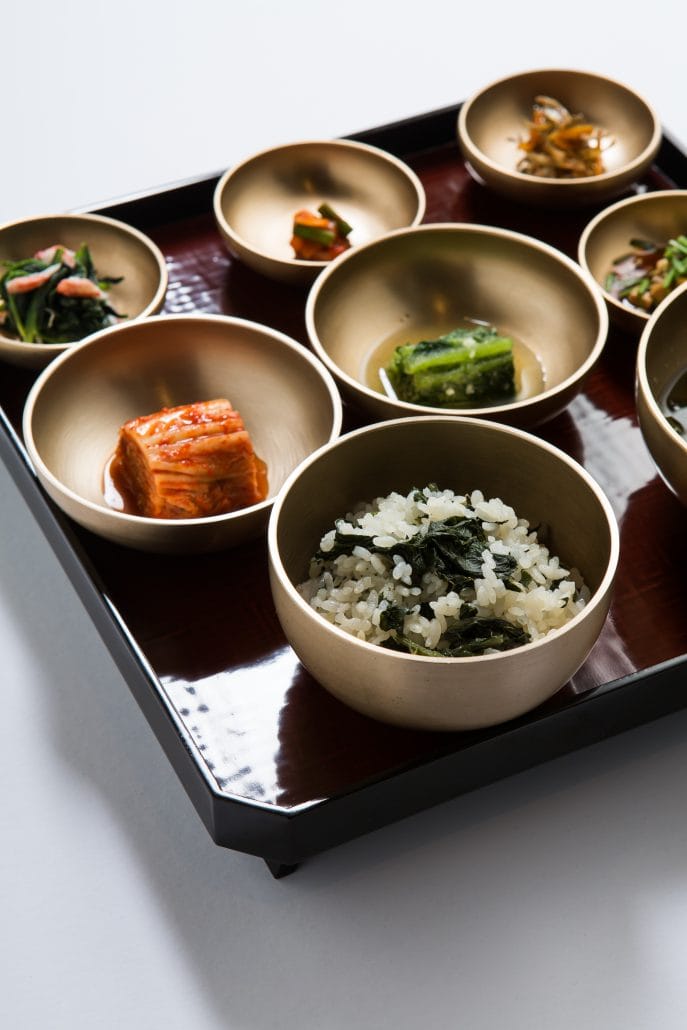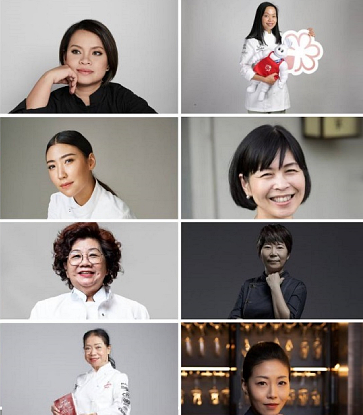Kim Byung-jin of the three-starred Michelin restaurant Gaon has a passion for Korean cuisine like no other. Inspired by dishes and flavors from centuries past, he has dedicated his career to tirelessly studying and developing recipes that reflect what he believes is the essence of Korean cuisine: natural simplicity.

Gaon has received three stars in the inaugural edition of the Michelin Guide Seoul 2017. How do you feel?
I am honored. More than anything, receiving the 3 Michelin stars is a great opportunity to generate more interest in Korean cuisine around the world. Hopefully, more people will grow to appreciate Korean food which will lead to more aspiring chefs wanting to study the roots of Korean gastronomy and open even better Korean restaurants. There are so many young chefs these days who have studied and worked abroad, but there is also a noticeable lack of them wanting to get into Korean food. Hopefully, Michelin’s decision to award Gaon with its highest honor will change that.
How long have you been cooking Korean cuisine?
After completing my culinary education in university, I started working in the kitchen at an establishment widely known as Korea’s first “fusion” restaurant. I also dabbled in Chinese food but eventually returned to Korean food and I’ve never looked back. My first professional experience cooking Korean food was while serving in the military; I was assigned to a type of KP duty at the residence of the Army Chief of Staff. I would cook Korean food every day for breakfast, lunch and dinner, and was also in charge of creating a Korean menu for the official dinner events that would take place around five times a month.
Why Korean cuisine?
That’s an interesting question. It’s interesting because I’ve been eating Korean food every day for 41 years of my life. What I hadn’t known was there is a world of Korean food that exists outside the realm of most people’s knowledge. There is an ocean of information and insights to be discovered in old literature. The deeper I investigated, the more curious I became – I wanted to know more and learn more. Well, here I am today, 14 years later.
Many years ago, Mr. Cho Tae-kwon, CEO of Gwangjuyo Group which operates Gaon, asked me what my dream was. I told him that I wanted to be a chef. To be a chef means to be a leader and he told me that to be a leader meant doing what I know I can do best. I was born here and I grew up here, so I believe my sensitivity for Korean cuisine is superior to that of any other non-Korean chef cooking Korean cuisine. Likewise, it would be difficult for an accomplished Korean chef specializing in French cuisine to rival his native French counterpart.

What have you learned about Korean cuisine since you began your journey?
Most Koreans think of Korean food as a colorful palette of an incredibly wide range of ingredients. The Korean food as we know it originated from the late Joseon Dynasty. The food prior to that time in Korean history focuses on the flavors of the ingredient itself. Centuries-old literature such as ‘Eumsikdimibang’ or ‘Suunjapbang’ clearly show that dishes from that time period focused on the integrity of the main ingredient rather than the harmony of many ingredients. I found it all fascinating.
You’ve been with Gaon since its opening in 2003 so this is your 14th year.
That’s right. I stayed on even when the restaurant closed in 2008. During the hiatus, I was in charge of ‘Hwayo Manchan,’ a series of private dinner parties Mr. Cho hosted at his residence four to five times a month featuring menus highlighting the best seasonal ingredients. That was an invaluable learning period for me. It was also a time of deep reflection and a lot of research.
What did you reflect about?
I would ask myself, ‘Is my heart really in this?’ During that time, I was pretty much a one-man show: I procured all the ingredients; I designed the menus; I created the stories; I considered every little detail on the menu; I chose all the plates and tableware; I even set the table. People would say to me, “Just get out. Why would you do that to yourself?” It was tough, but I stayed on because it was also a lot of fun.
What was fun about it?
I was able to get real-time feedback from the guests. And, I liked being in charge from A to Z. When Gaon re-opened in 2015, I was ready. I joined creative forces with Gaon Society President Cho Hee-kyung and Bicena’s executive chef Bang Ki-soo, so it was a little less pressure on my part compared to the Hwayo Manchan days. It still wasn’t easy, but I became more relaxed.

What kind of experience does Gaon offer?
I want the restaurant to be a place where people can go, enjoy themselves, and walk out with a genuine appreciation of our food, our culture and our values. For most people, going to a restaurant is simply about the act of eating. At Gaon, we offer a more comprehensive experience. Every detail–the space, the employee uniforms, the music that we play–embodies the cultural elements of Korean cuisine, so during the three or four hours that constitute a meal, our guests will be able to really breathe and experience Korea.
What inspires you?
On my days off, I like to go where there are lots of people. I sit in a quiet café and watch the people go by. My stream of thought always ends with the question, ‘What would these folks enjoy eating? What did they come here to eat?’ Busy neighborhoods are usually known for their popular eateries. So, I get a lot of ideas by people watching. I also read a lot. I usually read old literature on Korean cuisine, but I also read foreign books. I don’t speak any foreign language, so I usually go for books with lots of photos. When I come across an image that piques my interest, I inevitably turn my attention to the recipe which leads me to test it out in my own kitchen. But, that kind of food doesn’t really reflect me nor my style of cooking, so these days, I just briefly look at the photos and move on to books about Korean cuisine.
Where do you source your ingredients?
I personally visit the local producers. I also check out the local markets like Noryangjin Fisheries Wholesale Market, Garak Agro-Fisheries and Food Market, Kyungdong Market and Jungbu Market three or four times a week with my sous chef.
Are ingredients a source of inspiration for you as well?
Of course. The first thing I do when creating a new menu is to make a list of all the seasonal ingredients. Then, I go through my old books to see how those ingredients were used back in the days. Then, I think. I ask myself what I can do to add my own touch to the dish. These are the processes I usually go through.
How would you describe the food at Gaon?
Just like I’d done when I was younger, many young chefs these days tend to put too many elements on a plate. For me, now, Korean food is all about “the beauty of empty space,” a concept often mentioned when people talk about traditional Korean cuisine. “Empty space” refers to simplicity. When people talk about Korean food being healthy, it’s the same idea – simple food that highlights the essence of the ingredient itself which comes from nature. The beauty of Korean cuisine is about being natural without combining too many elements on a plate. The color and the texture of the vessel that holds the food and the elegant harmony they create together is what I define as “the style of Gaon.”
What is fine dining for you?
For many, fine dining is all about French or Japanese cuisine. Let’s take Kaiseki Ryori, a traditional multi-course Japanese haute cuisine, as an example. There is a deliberate flow and an undeniable balance that completes the story at the end of a meal. That is my definition of fine dining. Many Koreans still think that a full-on spread comprising as many dishes as possible is the way to serve guests. Although the visual impact of it may wow the guests at first, in the end, not one dish stands out. When there is a story to be told and that story is narrated in a way that connects the chef with his guests, then that to me is fine dining.
Although there has been a slight shift in the last decade or so, Korean food overseas is still very limited. What can we do to show people outside of Korea that there is so much more to Korean gastronomy than kimchi, barbecue and bibimbap?
The Michelin Guide is a good start. The reason why so many people are showing interest in the guide book is that it offers a global standard. This is only the beginning for us. We can’t expect the rest of the world to appreciate the diversity of our food overnight just because Michelin has started to recognize it. Koreans also need to start embracing the diversity in their gastronomy. We can’t recommend something to people if we don’t like it, much less know about it.

How do you want the world to perceive Korean cuisine?
I want people to understand that the best kind of Korean food is simple food, natural food. The fundamental food philosophy in the East is that good food cures all illnesses. Even Socrates once said that whatever illness one cannot cure with food, no medicine can. Taste and enjoyment constitutes a huge part of eating, but health is just as important.
What’s good to eat right now?
In the winter, most seafood tastes great as do root vegetables – they are chock-full of nutrients. Also, contrary to what most people believe, meats are seasonal, too, and right now is when they taste the best. To endure the harsh winter months, animals—including humans—store as many nutrients in their bodies as they can. That’s why meats taste so great around this time of the year.
What is your favorite food?
I love dakgalbi. I am originally from Chuncheon in Gangwondo Province and so, for me, dakgalbi is soul food. Food has a powerful way of bringing people closer together. Dakgalbi is a communal meal where people typically sit around a big round cast iron pan. The vibe is animated and convivial and I just love that.

Is there a particular dish you would like to recommend from the menu and a drink to go with it?
I would recommend the braised abalone with Songyeopju, a traditional pine liquor. Abalone lives on the sea bottom and feeds on algae. The scent of pine needles reminds me of the deepest forests. Taste is the outcome of various sensory stimuli, including touch and memories. I think the flavors of the deep ocean really complement the scents of the deep forest.
What are your future plans?
I just want to keep doing what I’m doing now. When something big comes along, people tend to use it to start something new and bigger, but I just want to continue my journey in Korean cuisine. I want to see more people develop a passion for Korean cuisine which will only make it better. I just want to cook.
Published 2016.11.20
















